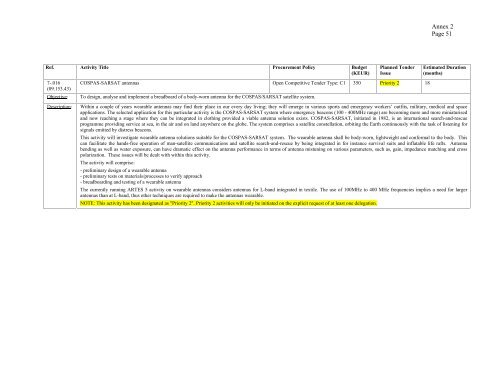ARTES-5.1 â ESA Telecom Technology Workplan ... - Emits - ESA
ARTES-5.1 â ESA Telecom Technology Workplan ... - Emits - ESA
ARTES-5.1 â ESA Telecom Technology Workplan ... - Emits - ESA
- No tags were found...
You also want an ePaper? Increase the reach of your titles
YUMPU automatically turns print PDFs into web optimized ePapers that Google loves.
Annex 2Page 51Ref. Activity Title Procurement Policy Budget(KEUR)Planned TenderIssueEstimated Duration(months)7-.016(09.153.43)Objective:Description:COSPAS-SARSAT antennas Open Competitive Tender Type: C1 350 Priority 2 18To design, analyse and implement a breadboard of a body-worn antenna for the COSPAS/SARSAT satellite system.Within a couple of years wearable antennas may find their place in our every day living; they will emerge in various sports and emergency workers’ outfits, military, medical and spaceapplications. The selected application for this particular activity is the COSPAS-SARSAT system where emergency beacons (100 - 400MHz range) are becoming more and more miniaturisedand now reaching a stage where they can be integrated in clothing provided a viable antenna solution exists. COSPAS-SARSAT, initiated in 1982, is an international search-and-rescueprogramme providing service at sea, in the air and on land anywhere on the globe. The system comprises a satellite constellation, orbiting the Earth continuously with the task of listening forsignals emitted by distress beacons.This activity will investigate wearable antenna solutions suitable for the COSPAS-SARSAT system. The wearable antenna shall be body-worn, lightweight and conformal to the body. Thiscan facilitate the hands-free operation of man-satellite communications and satellite search-and-rescue by being integrated in for instance survival suits and inflatable life rafts. Antennabending as well as water exposure, can have dramatic effect on the antenna performance in terms of antenna mistuning on various parameters, such as, gain, impedance matching and crosspolarization. These issues will be dealt with within this activity.The activity will comprise:- preliminary design of a wearable antenna- preliminary tests on materials/processes to verify approach- breadboarding and testing of a wearable antennaThe currently running <strong>ARTES</strong> 5 activity on wearable antennas considers antennas for L-band integrated in textile. The use of 100MHz to 400 MHz frequencies implies a need for largerantennas than at L-band, thus other techniques are required to make the antennas wearable.NOTE: This activity has been designated as "Priority 2". Priority 2 activities will only be initiated on the explicit request of at least one delegation.
















